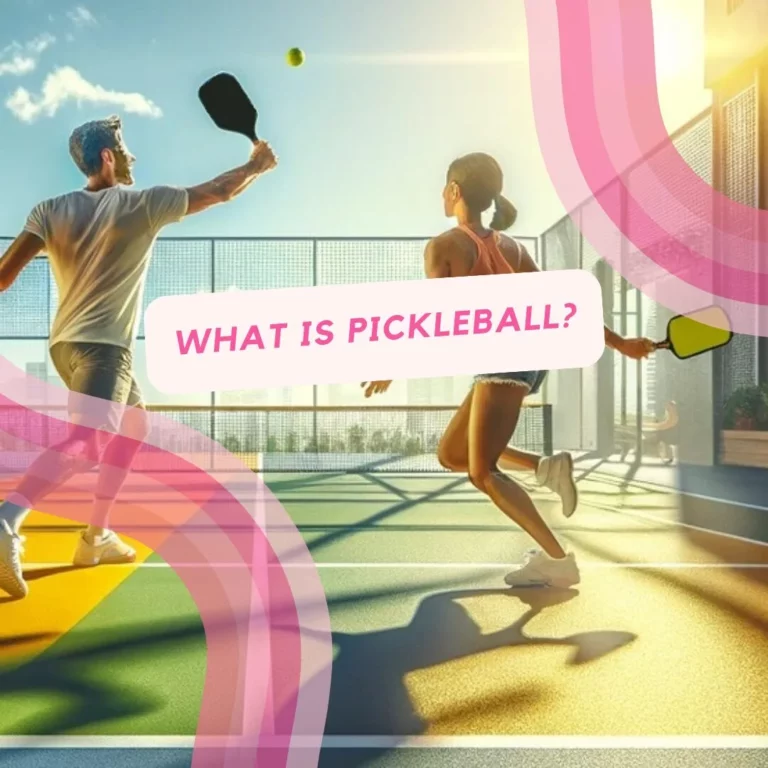Pickleball Indoors vs Outdoors
Pickleball Indoors vs Outdoors: What’s the Difference?
When comparing Pickleball Indoors vs Outdoors, there are several factors to consider that impact gameplay, from court surfaces and lighting to the type of ball, eyewear, and weather conditions. Whether you’re a beginner or an advanced player, understanding these differences will help you choose the best environment for your skill level and enjoyment.
Pickleball Courts: Indoors vs Outdoors
Both indoor and outdoor pickleball courts follow the same layout and dimensions: 20 x 44 feet (6.10 x 13.41 m), with a minimum playing surface of 30 x 60 feet (9.14 x 18.29 m). The non-volley zone, or kitchen, is identical in both environments. However, the surface you play on can drastically impact your game.
Indoor courts are typically made from hardwood, like basketball or badminton courts, which can lead to smoother but sometimes slipperier conditions for pickleball. Indoor balls often slide more on these wooden gym floors due to their slick surfaces. However, some private facilities have opted to build outdoor-style courts indoors, offering surfaces like concrete or asphalt to replicate outdoor conditions without exposure to the elements.
Outdoor pickleball courts, usually made of concrete or asphalt, offer faster ball bounces due to the harder surface. These courts are more durable and can handle exposure to different weather conditions, making them the standard for outdoor play.
Lighting Differences in Indoor vs Outdoor Pickleball
Lighting is another factor that distinguishes Pickleball Indoors vs Outdoors. Some indoor facilities provide consistent artificial lighting, ensuring clear visibility regardless of the time of day. This makes indoor courts ideal for evening games or settings where precision and focus on the ball are crucial. But other facilities lack proper lighting for pickleball.
In contrast, outdoor play relies on natural light. Sun glare, shadows, and varying brightness levels throughout the day can affect your visibility. For players sensitive to light, outdoor play can present challenges, especially during early morning or late afternoon when the sun is lower in the sky. Additionally, outdoor courts without proper lighting may limit night play.
Pickleball Balls: Indoor vs Outdoor
The ball type is one of the most critical differences in Pickleball Indoors vs Outdoors. While both indoor and outdoor balls must meet the same basic standards for size, weight, and bounce as outlined by USA Pickleball, their designs vary to suit specific environments.
One of the key differences between indoor and outdoor balls is the number of holes. Indoor pickleballs typically have 26 larger holes, which provide better control in environments without wind. This design minimizes drag and allows for smoother ball movement on indoor courts, where wind is not a factor.
Outdoor pickleballs, on the other hand, have 40 smaller holes. The increased number of smaller holes reduces wind drag, making the ball more stable in windy conditions. The extra weight of the outdoor ball, combined with its perforation pattern, helps counteract the impact of wind, allowing for more predictable ball flight during outdoor games.
Weather Conditions: How They Impact Outdoor Pickleball
One of the most significant factors in outdoor pickleball is weather, which can vary greatly and introduce many challenges. Here’s how different conditions affect outdoor play:
Wind
Wind is one of the biggest challenges in outdoor pickleball. Strong winds can drastically alter the ball’s trajectory, making it difficult to control. Outdoor pickleballs, with their 40 smaller holes, are specifically designed to handle wind better than indoor balls. The extra holes reduce wind drag and help keep the ball on a more stable flight path. However, even with these design elements, players still need to adjust their shots, aiming lower to counteract upward drafts or hitting with more force when playing into the wind. Tailwinds may make the ball move faster than expected, so developing strategies for wind control is essential for outdoor play.
Rain
Rain can stop outdoor pickleball altogether. Wet courts become slippery, making it unsafe to play. In addition, rain affects the ball’s bounce, causing it to skid instead of bouncing normally. If there’s even a slight drizzle, players should be cautious and check the court surface regularly to avoid slipping.
Sun
The sun poses both visibility and health challenges. Glare from the sun can make it hard to see the ball clearly, especially during midday. Players often wear hats, sunglasses, or visors to reduce glare. Sun exposure also means using sunscreen to protect skin from harmful UV rays. The sun can sap energy faster, so hydration is crucial during outdoor games in sunny conditions.
Heat and Humidity
High heat and humidity are common in outdoor pickleball, especially during summer. These conditions can increase the risk of dehydration and heatstroke. Players should be prepared with plenty of water, wear light, moisture-wicking clothing, and take frequent breaks to avoid overheating. Humidity also affects ball performance, as moisture in the air can slow down ball flight and reduce bounce consistency.
Cold
Cold weather affects the bounce of the pickleball. In colder temperatures, the ball becomes harder and less bouncy, which can make rallies slower and more difficult to control. Players may need to adjust their shots to account for the reduced bounce. Cold weather also makes it harder to keep muscles warm, so proper warm-ups are essential to avoid injury.
Sleet and Snow
Sleet and snow can bring outdoor pickleball to a halt. Much like rain, snow and ice make the court slippery and unsafe for play. The cold, combined with the wet conditions, can also damage equipment. In colder climates, outdoor pickleball is usually only played in fair weather seasons.
Eyewear for Indoor and Outdoor Pickleball
Whether playing Pickleball Indoors vs Outdoors, proper pickleball eyewear is essential for both protection and performance. Indoors, eyewear is important for eye protection, especially in fast-paced games where the ball can travel quickly, posing a risk to your eyes. Dim lighting in some indoor facilities can also make it harder to track the ball, so players often use eyewear with clear or yellow-tinted lenses to enhance visibility in low light.
Outdoor pickleball presents additional challenges. Sun glare can make it difficult to see the ball clearly, especially during midday games. For outdoor play, sunglasses with polarized lenses are a good option to reduce glare and enhance contrast. UV protection is also vital, as prolonged exposure to the sun can harm your eyes. Players should choose eyewear with dark or mirrored lenses for bright conditions and photochromic lenses for games that transition between sun and shade.
Indoor Pickleball: Pros and Cons
Indoor pickleball offers a controlled environment, making it ideal for beginners or those who prefer consistent conditions. Without wind or weather to worry about, the ball’s flight is predictable, and the bounce is more even across the court. Indoor facilities often provide amenities like climate control and consistent lighting, allowing for extended play without the physical toll of outdoor conditions.
One downside of indoor play is the noise level. The sound of the ball hitting the paddle can echo loudly in enclosed spaces, making it distracting for some players. Additionally, the sliding effect of the ball on smooth gym floors can change the pace of the game, making it feel faster.
Outdoor Pickleball: Pros and Cons
Outdoor pickleball offers a more dynamic experience. The heavier ball and harder court surface result in faster-paced games, which can be more enjoyable for advanced players looking for a challenge. Weather conditions like wind, sun, and even rain can add complexity to the game, making outdoor play a true test of adaptability and skill.
However, outdoor games require more preparation. Sun exposure can lead to discomfort, so players need to come prepared with sunblock, hats, and sunglasses. Outdoor courts are also more prone to wear and tear from environmental conditions, and the balls themselves can degrade faster due to rough surfaces and exposure to the elements.
Questions and Answers
What is the main difference between pickleball indoors vs outdoors?
The main difference between indoor and outdoor pickleball is the type of ball and surface. Indoor balls are lighter and have 26 larger holes, which reduces drag in controlled environments, while outdoor balls are heavier and have 40 smaller holes to reduce wind drag and perform better in outdoor conditions.
What eyewear should I use for indoor pickleball?
For indoor pickleball, clear or yellow-tinted lenses are recommended to improve visibility in dim lighting. Protective eyewear is also essential to shield your eyes from fast-moving balls.
What kind of sunglasses are best for outdoor pickleball?
For outdoor pickleball, polarized sunglasses are ideal to reduce glare from the sun. Lenses with UV protection are a must to protect your eyes from harmful sun exposure, and photochromic lenses work well in variable light conditions.
How does weather affect outdoor pickleball?
Weather conditions like wind, rain, sun, and extreme temperatures all impact outdoor pickleball. Wind affects ball flight, rain makes courts slippery, and sun glare can affect visibility. Heat and cold both affect player performance and the ball’s bounce.
Which Is Better for You?
When weighing the pros and cons of Pickleball Indoors vs Outdoors, the choice often depends on your skill level and preferences. Beginners often prefer indoor pickleball due to its controlled environment and consistent lighting, which make it easier to focus on technique. However, the slick gym floors may introduce challenges with ball control.
Outdoor pickleball, on the other hand, is perfect for players looking to test their skills in a more dynamic environment. Wind, sun, and surface variability require quick reflexes and adaptability, making outdoor play more challenging but rewarding for advanced players.
Regardless of where you play, proper eyewear and sun protection are essential, especially for outdoor games. As you develop your skills, don’t hesitate to switch between the two environments to enhance different aspects of your game. Pickleball is a versatile sport that can be enjoyed year-round, so find what works best for you and keep practicing!







